Uncover the surprising protein content in chicken wings and discover which cuts offer optimal nutrition for your
A typical chicken wing offers about 6.4g of protein in an 85g serving, making it a significant protein source for your dietary needs. Factors like grilling or baking can slightly increase protein levels compared to fried wings, with skin-on wings having more protein. Different wing cuts vary in protein content; drumettes tend to have more protein than flat wings. Understanding these distinctions can help you choose the most protein-rich options for your meals.
Table of Contents
Key Takeaways
- A single chicken wing contains around 6.4g of protein per 85g serving.
- Grilled or baked wings offer slightly higher protein levels compared to fried wings.
- Protein content varies based on cooking method, skin retention, and wing cuts.
- Drumettes have higher protein content than flat wings.
- Protein in wings is essential for muscle repair and growth.
Protein Content in Chicken Wings
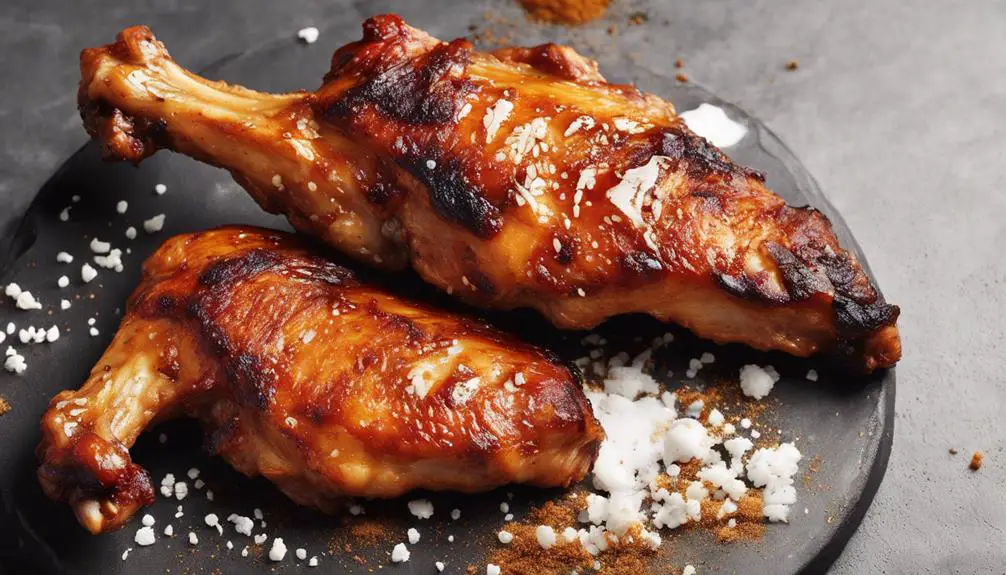
When examining the protein content in chicken wings, it becomes apparent that they're a significant source of this macronutrient. A single chicken wing provides an average of 6.4g of protein per 85g serving, indicating a rich protein content. In fact, on average, chicken wings contain around 24g of protein per 100g, making them a dense source of this essential nutrient. Even a medium-sized chicken wing with skin intact contributes around 8.52g of protein. Protein makes up about 64% of the calories in skinless, boneless chicken wings, highlighting its importance in this food item.
Including chicken wings in your diet can significantly boost your protein intake, which is vital for muscle health and repair. Whether you enjoy them as a snack or part of a meal, these wings offer a substantial amount of protein, aiding in meeting your daily nutritional requirements. Incorporating chicken wings into your diet can be a flavorful way to increase your protein consumption and support your overall well-being.
Factors Affecting Protein Levels
Factors affecting the protein levels in chicken wings include the cooking method utilized and whether the skin is retained. When it comes to protein content, grilled or baked chicken wings generally have slightly higher levels compared to fried wings. The removal of the skin can impact not only the fat content but also the protein levels in the wings. Here is a table summarizing how these factors influence the protein content in chicken wings:
| Factors | Impact on Protein Content |
|---|---|
| Cooking Method | Grilled or Baked > Fried |
| Skin Retention | Skin Removed < Skin Kept |
Paying attention to these factors can help you make choices that align with your dietary preferences or requirements. Remember, small changes in the cooking process or skin removal can influence the protein levels in your chicken wings, providing you with options to suit your nutritional needs.
Protein Variability in Different Wing Cuts
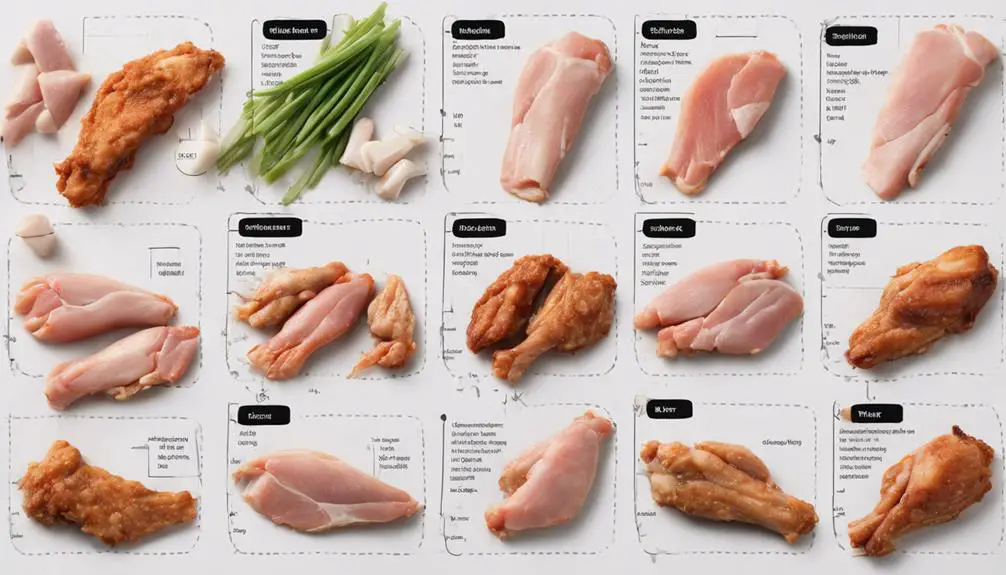
In contemplating the protein variability in different wing cuts, it's crucial to note that various cuts of chicken wings offer varying amounts of protein. This variation can impact the overall protein intake and nutritional value of the chicken wing consumption.
Here are some key points to ponder when it comes to the protein content in different wing cuts:
- Drumettes generally have a higher protein content compared to flat wings.
- Large wings tend to provide a substantial amount of protein per serving.
- Skin-on wings may contain slightly less protein than skinless wings due to the skin's presence.
- Eating a combination of different wing cuts can help balance your protein intake and provide a diverse range of nutrients.
Understanding these differences can assist you in making informed choices to meet your dietary requirements, especially if you're aiming for a high protein intake. By selecting the right wing cuts, you can guarantee you're getting the protein levels your body needs.
Impact of Cooking Methods on Protein
Exploring how different cooking methods affect the protein content of chicken wings provides valuable insights into optimizing your dietary protein intake. The protein content in chicken wings remains important regardless of the cooking method used. Whether you choose to grill or fry your wings, each medium-sized wing serving will provide you with approximately 8.52g of protein. This protein is vital for muscle repair and growth, making chicken wings a popular choice among individuals looking to increase their protein intake.
When considering cooking methods, it's crucial to note that the protein content in chicken wings is resilient to variations caused by grilling or frying. Both methods offer the same amount of protein per serving, ensuring that you receive the necessary nutrients regardless of your preferred cooking style. By understanding this aspect of cooking methods and protein content, you can confidently select the preparation method that aligns with your taste preferences without compromising your dietary protein intake. Experimenting with different cooking methods can add variety to your meals while ensuring you meet your protein requirements.
Protein in Fried Chicken Wings
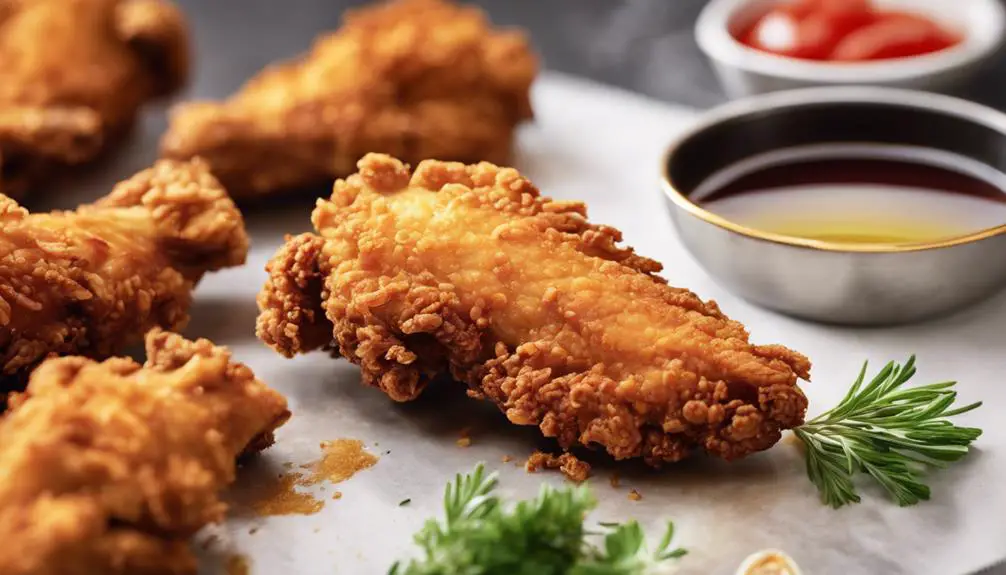
Fried chicken wings offer a protein content of approximately 6.4g per 85g serving, making them a flavorful source of dietary protein. When you indulge in these savory treats, you not only satisfy your taste buds but also provide your body with essential nutrients.
- The protein content in fried chicken wings can vary based on factors like size and cooking method, influencing the overall nutritional value.
- While a medium-sized fried chicken wing with skin can provide around 8.52g of protein, it's important to be mindful of portion sizes to maintain a balanced diet.
- Opting for grilled or baked wings over fried ones can offer a healthier protein option, reducing the intake of excess fats and calories.
- Including chicken wings in moderation can contribute positively to your daily protein intake, supporting muscle growth and repair.
Protein in Grilled Chicken Wings
Grilled chicken wings provide around 8.52g of protein per medium serving, aiding in muscle repair and growth.
Comparing the protein content in fried versus grilled wings highlights the healthier choice of grilling.
Including grilled chicken wings in your diet not only offers a tasty protein source but also contributes to meeting daily protein intake goals.
Grilled Wing Protein Content
When considering the protein content of grilled chicken wings, it's essential to note that a medium-sized wing typically contains around 8.52g of protein.
Grilled chicken wings offer a healthier alternative with lower fat content compared to fried wings.
The protein content in grilled chicken wings remains consistent regardless of the cooking method.
Grilling chicken wings provides a unique flavor profile that enhances the overall taste.
Opting for grilled chicken wings can help individuals meet their protein intake goals while enjoying a delicious meal.
Protein Comparison: Fried Vs. Grilled
To compare the protein content of fried and grilled chicken wings, it's essential to analyze their nutritional profiles thoroughly. Grilled chicken wings typically contain around 8.52g of protein per medium-sized wing with skin. Whether fried or grilled, the protein content remains consistent.
Opting for grilled chicken wings offers a healthier choice with lower calorie and fat content compared to frying. Consuming 10 grilled chicken wings can provide approximately 85.2g of protein. This makes grilled chicken wings a nutritious option for increasing protein intake while managing calorie and fat consumption effectively.
When choosing between fried and grilled chicken wings, opting for the grilled version can satisfy your protein needs without compromising on health benefits.
Health Benefits of Protein
Protein content in grilled chicken wings contributes significantly to enhancing overall health by supporting important functions like wound healing, new cell formation, and immunity. Here are some health benefits of protein found in grilled chicken wings:
- Protein aids in wound healing, promoting faster recovery.
- Protein supports new cell formation, essential for growth and repair.
- Protein boosts immunity, helping the body defend against illnesses.
- Protein helps regulate blood glucose levels and supports ideal brain function.
Including grilled chicken wings in your diet provides a nutritious option rich in essential protein, offering numerous health benefits for your overall well-being.
Nutritional Value of Chicken Wing Sauces
The nutritional value of chicken wing sauces varies considerably depending on the type of sauce used, impacting factors such as calorie content and sugar levels. Sauces can add a significant amount of flavor and variety to your chicken wings, but it's important to be mindful of their nutritional content. Below is a table outlining some key nutritional information about popular chicken wing sauces:
| Sauce Type | Calories per Serving | Sugar per Serving | Protein per Serving |
|---|---|---|---|
| Buffalo | 5-20 calories | 1g | 0g |
| BBQ | 60-70 calories | 12g | 0g |
| Teriyaki | 60-80 calories | 8g | 2g |
| Honey Mustard | 60-80 calories | 6g | 1g |
Buffalo sauce stands out as a lower-calorie option with minimal sugar, making it a good choice for those watching their calorie intake. On the other hand, BBQ sauce adds sweetness and flavor but contains a higher sugar content. Teriyaki sauce offers a sweet and savory taste but is high in sugar. Honey mustard strikes a balance between sweetness and protein content. Consider these factors when selecting the sauce for your chicken wings to align with your dietary preferences and health goals.
Protein in Buffalo Sauce Wings
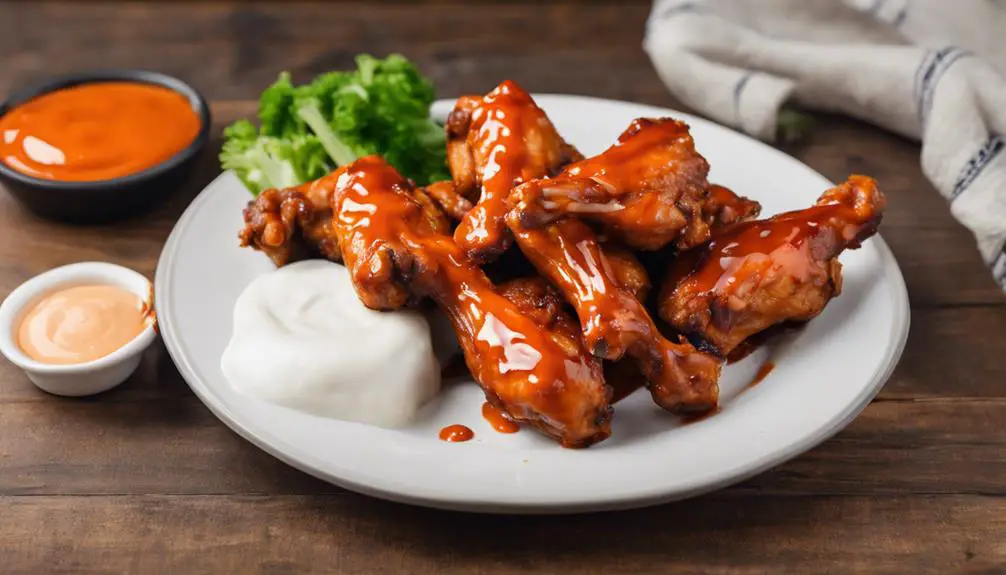
Buffalo sauce wings provide around 8.52g of protein per medium serving, making them a notable protein source. Analyzing the protein content in buffalo sauce wings allows for comparison with other wing varieties.
The cooking method used for buffalo sauce wings can also impact their overall nutritional value.
Protein Content Comparison
When enjoying buffalo sauce wings, it's essential to factor in the protein content for accurately monitoring your daily intake. The protein content comparison of buffalo sauce wings offers insight into the nutritional value you're consuming.
Here are some key points to contemplate:
- Buffalo sauce wings provide a consistent amount of protein across various cooking methods.
- Grilled chicken wings maintain a similar protein content to fried wings.
- The protein content in buffalo sauce wings is essential for supporting muscle repair and growth.
- Understanding the protein content in buffalo sauce wings assists in meeting your daily protein requirements effectively.
Nutritional Value Analysis
To analyze the nutritional value of buffalo sauce wings, consider the protein content as an essential component for understanding their dietary impact. When buffalo sauce is added to chicken wings, the protein content remains primarily from the chicken itself, providing about 8.52g per medium-sized wing with skin. Protein is important for muscle repair and overall body function, making buffalo sauce wings a decent source of this macronutrient.
Cooking Method Impact
Considering different cooking methods for buffalo sauce wings, the impact on protein content remains consistent, providing a reliable source of this essential macronutrient. When enjoying boneless chicken wings with buffalo sauce, whether fried or grilled, rest assured that you're still getting a protein-packed meal. This consistency allows you to savor the flavors without compromising on the nutritional value. Buffalo sauce wings offer a delicious way to meet your protein needs while indulging in a classic dish. So, whether you prefer them fried or grilled, you can count on buffalo sauce wings to deliver a tasty and protein-rich dining experience.
- Buffalo sauce wings maintain protein content across cooking methods.
- Boneless chicken wings offer a convenient and protein-packed option.
- Enjoy the classic taste of buffalo sauce wings with a consistent protein supply.
- Indulge in flavorful boneless chicken wings without compromising on protein intake.
Protein in BBQ Sauce Wings
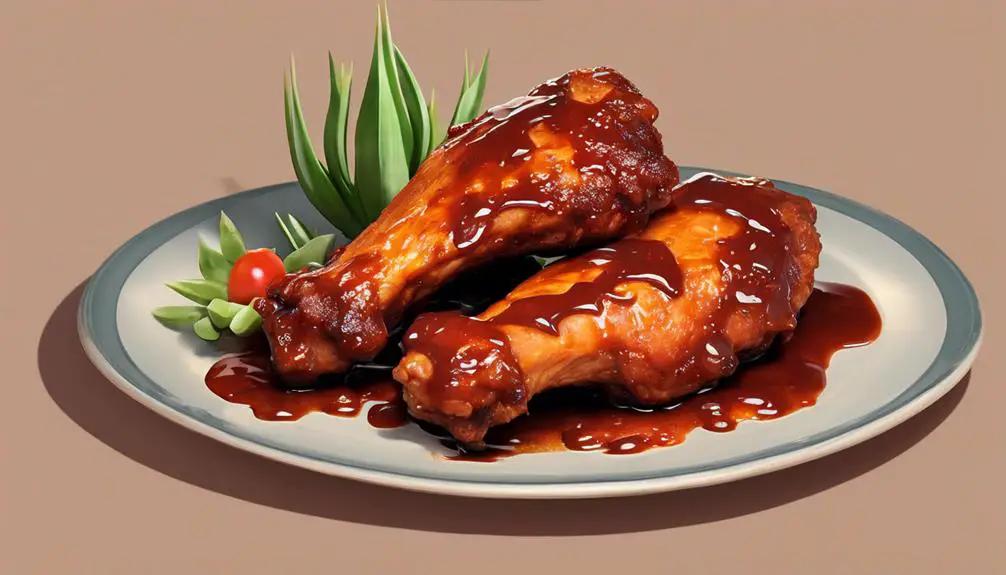
In BBQ sauce wings, the protein content per medium-sized wing usually amounts to about 8.52g, adding considerably to their nutritional profile. Protein plays an essential role in supporting muscle growth and repair in the body, making BBQ sauce wings not only delicious but also beneficial for your overall health. Including BBQ sauce wings in your diet is a flavorful way to increase your protein intake, which is crucial for various bodily functions.
Moreover, the protein content in BBQ sauce wings contributes immensely to their nutritional value, making them a satisfying and wholesome choice. Whether you enjoy them as a snack, appetizer, or main course, BBQ sauce wings offer a tasty protein source that can be enjoyed by many. So, the next time you crave a flavorful dish, choosing BBQ sauce wings can be a tasty and protein-packed option to satisfy your hunger and support your body's protein needs.
Protein in Teriyaki Sauce Wings
When exploring the protein content of teriyaki sauce wings, you'll find that they provide approximately 8.52g of protein per medium serving, contributing noticeably to their nutritional value. This protein content plays a vital role in muscle maintenance and growth, helping you achieve your daily protein intake goals. In addition to supporting bodily functions, the protein in teriyaki sauce wings aids in tissue repair, making it a beneficial addition to your diet.
Here are some points to ponder about the protein in teriyaki sauce wings:
- The protein content in teriyaki sauce wings is essential for muscle health and repair.
- Including teriyaki sauce wings in your meals can help you reach your daily protein requirements.
- Protein in teriyaki sauce wings offers a flavorful and satisfying way to consume this essential nutrient.
- Enjoying teriyaki sauce wings adds variety to your diet while providing the necessary protein for overall well-being.
Protein in Dry Rub Wings
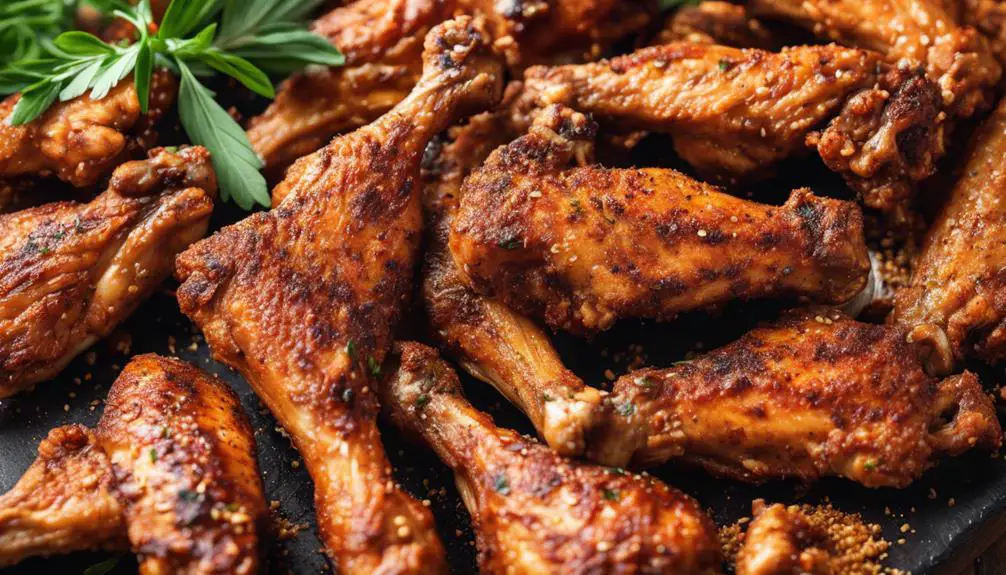
Exploring the protein content of dry rub wings reveals that they typically provide around 6.4g of protein per 85g serving, making them a flavorful and protein-rich option for your meals. The amount of protein in dry rub wings can vary slightly depending on factors like the size and type of the wing, but this protein content remains relatively consistent across different preparation methods. Dry rub wings offer a delicious alternative to saucy wings, maintaining their protein integrity while appealing to those who prefer a drier coating.
Including dry rub wings in your meal plan can contribute markedly to your daily protein intake. With their savory flavors and protein-packed profile, they serve as a satisfying choice for those seeking both taste and nutrition. Whether you enjoy them as a snack, appetizer, or main dish, dry rub wings are a versatile option that can add variety and a substantial amount of protein to your diet.
Protein in Lemon Pepper Wings
Lemon pepper wings offer approximately 8.52 grams of protein per medium-sized wing with skin, making them a protein-rich option. The protein content may vary based on factors like wing size and cooking techniques.
Incorporating lemon pepper wings into your diet can provide a flavorful protein source to support your nutritional needs.
Lemon Pepper Wing Recipe
Enhance the nutritional value of your lemon pepper wings by grilling or baking them, which can improve their overall protein content and flavor profile. When making lemon pepper wings, consider the following tips to elevate your culinary experience:
- Marinate the wings in lemon juice and pepper for at least 30 minutes before cooking.
- Sprinkle extra lemon pepper seasoning after grilling or baking for an added burst of flavor.
- Serve the wings with a side of fresh lemon wedges for an extra zing.
- Experiment with different cooking times to achieve the perfect balance between tenderness and crispness.
These simple steps can turn your chicken wings into a delicious and protein-packed dish that you can enjoy with friends and family.
Nutritional Value Breakdown
To determine the protein content of lemon pepper wings accurately, one must consider the various cooking methods and their impact on the nutritional value. When it comes to protein, a medium-sized lemon pepper chicken wing with skin provides approximately 8.52g of this essential nutrient.
However, opting for grilled, roasted, or stewed wings can increase the protein content to around 9g per serving. Skinless chicken wings contain a similar protein content, averaging 8.52g per medium wing. Understanding the protein levels in lemon pepper wings is important for meal planning and achieving dietary goals.
Protein in Honey Mustard Wings
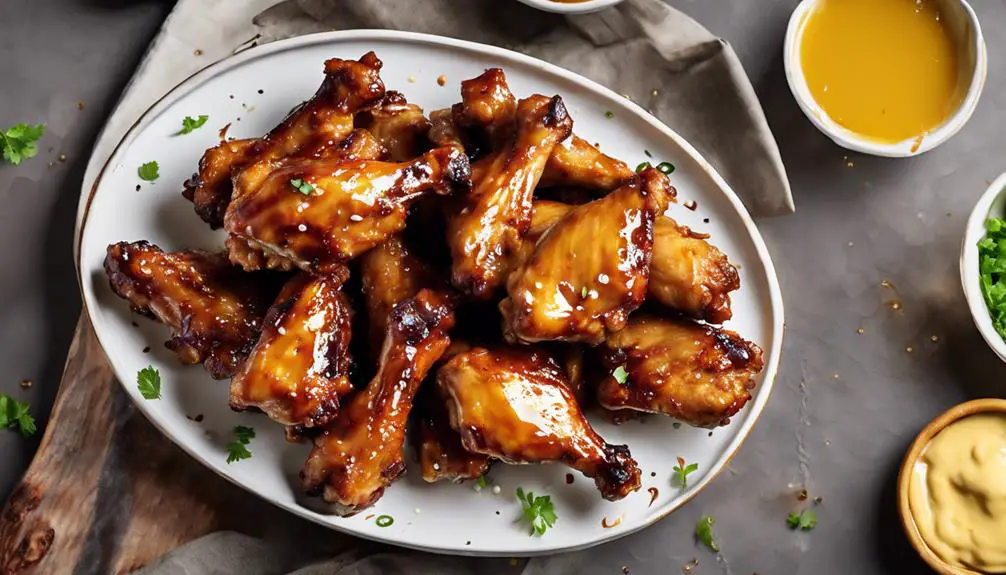
When preparing honey mustard wings, the protein content typically ranges around 8.52g per serving, varying based on factors like size and cooking method. Protein is an essential nutrient found in chicken wings, including those coated in honey mustard sauce. Here are some key points to think about concerning the protein content in honey mustard wings:
- Enjoy the flavorful combination of honey mustard sauce while benefiting from a good protein intake.
- Remember that the protein content can vary depending on how the wings are prepared and their size.
- Incorporating honey mustard wings into your diet in moderation can be a tasty way to increase your daily protein consumption.
- Indulge in the delicious taste of honey mustard wings knowing that you're also consuming a decent amount of protein.
Including honey mustard wings in your meal plan can't only satisfy your taste buds but also contribute to meeting your protein needs. So, enjoy this delectable dish while nourishing your body with essential nutrients.
Protein in Garlic Parmesan Wings
If you're looking to explore the protein content of Garlic Parmesan wings, you'll find that they typically pack around 9-10g of protein per medium-sized wing. The protein content in Garlic Parmesan wings can vary based on the cooking method and recipe.
Protein is an essential macronutrient that plays an important role in muscle maintenance and repair. By enjoying Garlic Parmesan wings, you not only indulge in a flavorful dish but also contribute to meeting your daily protein needs.
These wings offer a tasty way to boost your protein intake while satisfying your cravings for a savory treat. Whether as a snack or part of a meal, Garlic Parmesan wings can be a delicious and protein-rich option to incorporate into your diet.
Best Protein-Rich Chicken Wing Options
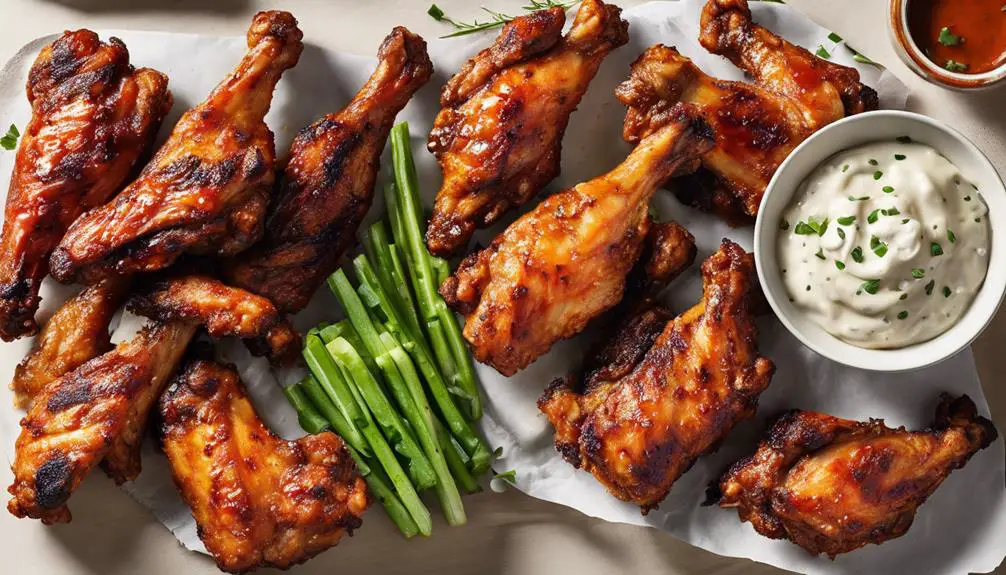
For those seeking protein-rich options, contemplate exploring the nutritional benefits of various types of chicken wings. When it comes to protein content, chicken wings can be a delicious and satisfying choice. Here are some of the best protein-rich chicken wing options to contemplate:
- Buffalo Wings: These classic wings provide a good amount of protein while offering a flavorful kick.
- Grilled Chicken Wings: Opting for grilled wings is a healthier choice that still packs a protein punch.
- Teriyaki Wings: These wings offer a unique flavor profile while also being a good source of protein.
- Honey BBQ Wings: If you prefer a sweeter wing option, honey BBQ wings can satisfy your cravings while still providing protein.
Frequently Asked Questions
How Much Protein Is in a Single Chicken Wing?
In a single chicken wing, you'll find varying protein content, typically around 6.4g per 85g serving or 24g per 100g. Grilled or baked wings preserve more protein than fried ones. Including wings in your diet boosts daily protein intake.
How Much Protein Is in 6 Piece Chicken Wings?
In a 6-piece serving of chicken wings, you'll find approximately 45.12 grams of protein. Each wing typically provides around 7.52 grams of protein. These protein-rich wings can greatly enhance your daily protein intake.
Are Wings High in Protein?
Wings are indeed high in protein, making them a great choice to boost your protein intake. With approximately 24g per 100g serving, they can help you meet your daily protein needs effectively. Enjoy them as part of a balanced diet.
How Much Protein Is in 6 Whole Chicken Wings?
When you consume 6 whole chicken wings, you're getting approximately 48 grams of protein. Each wing contributes around 8 grams of protein, making them a valuable source of protein in your diet.
Conclusion
To sum up, the protein content in chicken wings can vary depending on factors such as the cut of the wing and cooking method.
Fried chicken wings tend to have higher protein levels compared to flavored varieties like lemon pepper or honey mustard.
For those seeking a protein-rich option, choosing grilled or baked wings may be the best choice.
Remember to take into account these factors when selecting your next chicken wing meal for a balanced and nutritious diet.

